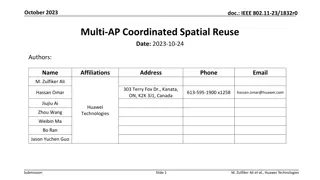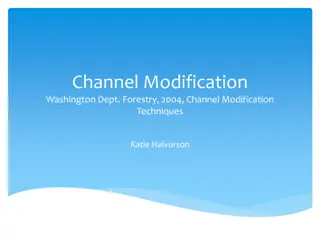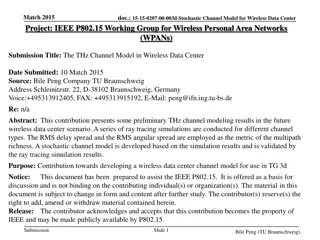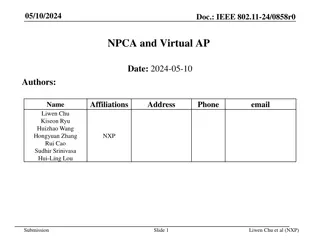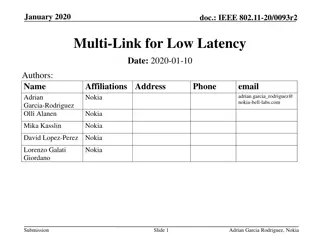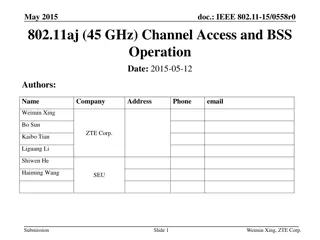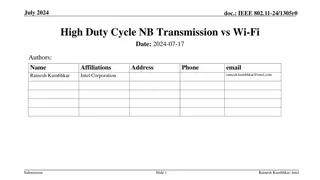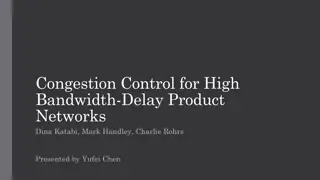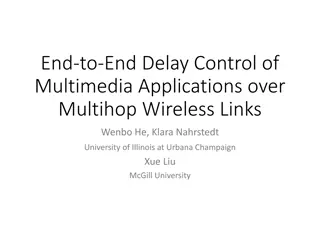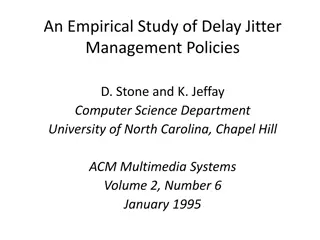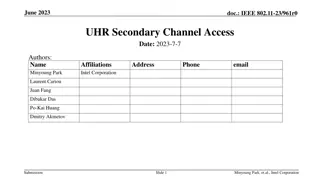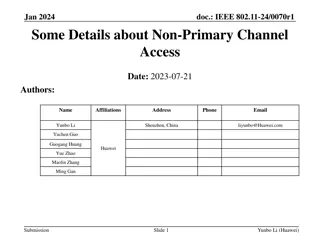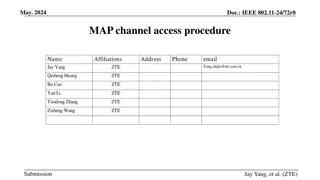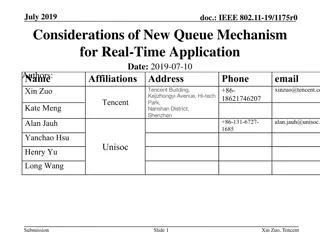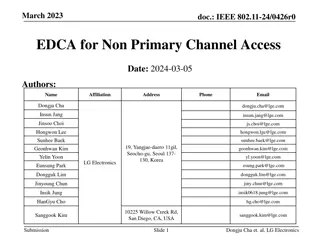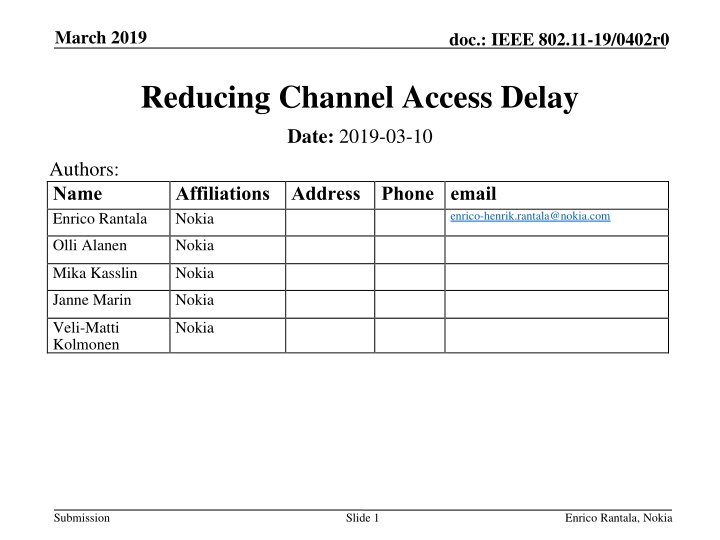
Reducing WLAN Latency with Multiple Primary Channels
Explore how the introduction of multiple primary channels in IEEE 802.11-19/0402r0 can help mitigate channel access delay, crucial for achieving reliable low-latency communication in WLAN environments. This presentation by Enrico Rantala from Nokia addresses the challenges of reducing latency in WLAN networks, especially in scenarios with mixed traffic and varying reliability requirements. Discover the proposed solution and its potential impact on improving latency performance in WLAN communications.
Download Presentation

Please find below an Image/Link to download the presentation.
The content on the website is provided AS IS for your information and personal use only. It may not be sold, licensed, or shared on other websites without obtaining consent from the author. If you encounter any issues during the download, it is possible that the publisher has removed the file from their server.
You are allowed to download the files provided on this website for personal or commercial use, subject to the condition that they are used lawfully. All files are the property of their respective owners.
The content on the website is provided AS IS for your information and personal use only. It may not be sold, licensed, or shared on other websites without obtaining consent from the author.
E N D
Presentation Transcript
March 2019 doc.: IEEE 802.11-19/0402r0 Reducing Channel Access Delay Date: 2019-03-10 Authors: Name Enrico Rantala Affiliations Address Phone email Nokia enrico-henrik.rantala@nokia.com Olli Alanen Nokia Mika Kasslin Nokia Janne Marin Nokia Veli-Matti Kolmonen Nokia Submission Slide 1 Enrico Rantala, Nokia
March 2019 doc.: IEEE 802.11-19/0402r0 Abstract Reducing latencies is one of the targets for EHT This is especially important in reliable low-latency (RLL) communications The channel access delay is the main components in total WLAN latency, and is heavily dependent on how busy the primary channel is, e.g. due to other BSSs Total WLAN latency = time at when packet arrives to sender MAC time at when the packet leaves the receivers MAC to upper layers Some work has been done to decrease the channel access delay as such 802.11ax spatial reuse framework 802.11ax OFDMA framework (scheduling) For low-latency, contention-based access may still be the best option, as scheduling causes always some delay We propose introducing a new feature in EHT to mitigate channel access delay: Multiple primary channels Submission Slide 2 Enrico Rantala, Nokia
March 2019 doc.: IEEE 802.11-19/0402r0 Reliable Low Latency Communication There are many use cases for RLL communications: Gaming, Industrial applications, Augmented Reality, ... The reliability and latency requirements of the use cases vary, but are often in the order of: 1ms 10ms latency with 99% - 99.9999% reliability In this presentation, we assume the latency requirement of 2ms or below for 99.9% of packets In e.g. cloud gaming 10ms delay is required. In such case 2ms one- way delay budget for the WLAN part might be suitable Submission Slide 3 Enrico Rantala, Nokia
March 2019 doc.: IEEE 802.11-19/0402r0 Reliable Low Latency Communication in OBSS environment If the environment, in which the RLL communications are needed, is isolated, such as in a factory: it may be possible to dedicate some channels to RLL communications, which would help on meeting the requirements Otherwise (if there are OBSSs): it is not possible to guarantee a free channel, and RLL communications need to share the channel with non-RLL communications, or even other radio technologies In such an OBSS environment, it is hard to provide RLL If the primary channel, e.g. happens to be busy for couple of 2ms TxOPs, the access delay will be already too long This is especially true in case of the OBSS is managed by another entity Submission Slide 4 Enrico Rantala, Nokia
March 2019 doc.: IEEE 802.11-19/0402r0 Simulation Scenario Indoor scenario with single room where all the devices are within -62dBm sensing range 80MHz of available spectrum 4 OBSS' APs each using its own 20MHz channel One broadband STA associated to each of the APs Bursty (4Mb burst) data transmissions on each AP/channel. The load is varied. A 5th 'RLL' AP The AP is put to any of the 20MHz channels, and stays there One RLL STA associated this AP 1500B packet every 250ms (= 48kbps) 99.9th percentile delay should be below 2ms Submission Slide 5 Enrico Rantala, Nokia
March 2019 doc.: IEEE 802.11-19/0402r0 Simulation results (one primary channel) The figure presents the 99.9th percentile delays of the RLL STA with different load percentages on the OBSS It is visible that even with the lowest load of 5%, the 99.9th delay percentile is 4ms, which is above the required 2ms 99.9th percentile delay When load on the OBSSs increases, the 99.9% delay goes even higher 2ms Submission Slide 6 Enrico Rantala, Nokia
March 2019 doc.: IEEE 802.11-19/0402r0 Problem: busy primary channel The problem of busy primary channel is most visible in the presence of RLL communications There are often scattered unused resources that could be more efficiently used, if the primary channel would not be such a limiting factor [1] There are WLAN white spaces out there, that should be used more efficiently Limiting the channel access to the single primary channel conditions causes these problems and makes the channel access inefficient Submission Slide 7 Enrico Rantala, Nokia
March 2019 doc.: IEEE 802.11-19/0402r0 Simulation Results (multiple primary channels) The figure presents the 99.9th percentile delays of the RLL STA with different load percentages on the OBSS 99.9th percentile delay with legacy RLL BSS operation and when using multiple primary channels (M-PCH) for the RLL BSS M-PCH increases the chances to find a free channel, instead of sticking to a busy one With lower OBSS loads, there is naturally almost always a free channel, which will reduce the channel access delay significantly 2ms Up to 20% OBSS load can be tolerated while providing the QoS Submission Slide 8 Enrico Rantala, Nokia
March 2019 doc.: IEEE 802.11-19/0402r0 Solution: Multiple primary channels An AP uses all the 20MHz channels within the maximum bandwidth as primary channels Associated STAs should use the same set of channels as primary channels Each STA and AP simultaneously runs an EDCA on each of the 20MHz primary channels Independent EDCA per channel, i.e. independent backoff counters, NAVs, When any of the 20MHz primary channels and the communication peer is idle, transmission can occur In receiving side, STAs and APs try to simultaneously find the synchronization signal from all the 20MHz primary channels When sync is achieved, STAs lock to that signal for reception The usual transmission bandwidths from 20MHz to 160MHz can be used with the solution Submission Slide 9 Enrico Rantala, Nokia
March 2019 doc.: IEEE 802.11-19/0402r0 Summary Channel access delay is a key factor for reliable low latency communications We propose that the EHT group investigates the possibility of decreasing the channel access delays One way to do this is to introduce a new feature that utilizes multiple primary channels per device Submission Slide 10 Enrico Rantala, Nokia
March 2019 doc.: IEEE 802.11-19/0402r0 References [1] IEEE 802.11-17/1699r7 - Introducing multiple primary channels to exploit unused resources scattered in multiple channels/bands IEEE 802.11-19/108r1 - Discussion on Multi-Band for EHT [2] Submission Slide 11 Enrico Rantala, Nokia


